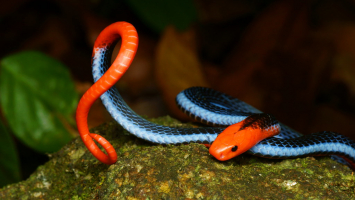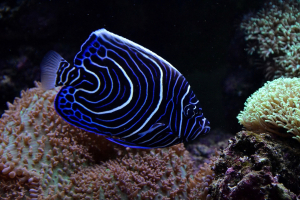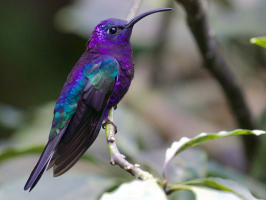Top 10 World's Most Beautiful Parrots
There are around 350 species of parrots in the world today and most live in the tropical and subtropical regions of Australia, Africa, and Central and South ... read more...America. Many of these have long been kept as pets and are as famous for their exceptionally bright and stunning colors as they are for their talking ability. Below is a list of the most beautiful parrots in the world, let's find out!
-
Australia is home to the Rainbow Lorikeet (Trichoglossus moluccanus), a species of parrot. The eastern seaboard, from northern Queensland to South Australia, is characterized by its prevalence. Its habitat is rainforest, coastal bush, and woodland areas. Previously classified as subspecies of the rainbow lorikeet, six taxa are now considered distinct species.
The rainbow lorikeet is a medium-sized parrot that weighs between 75 and 157 g and measures between 25 and 30 cm long, including the tail. As with all subspecies, the nominate race has extremely vivid and colorful plumage. The upper body, including the wings, back, and tail, are all green, with the head being a deep blue color with a greenish-yellow nuchal collar. It has an orange-yellow chest. The thighs and rump are green, while the belly has a deep blue color. A yellow wing bar and the red underwing coverts stand out sharply in flight. The visual differences between the sexes are minimal. A black beak is present in juveniles; it gradually turns orange in adults.

Wikimedia Commons 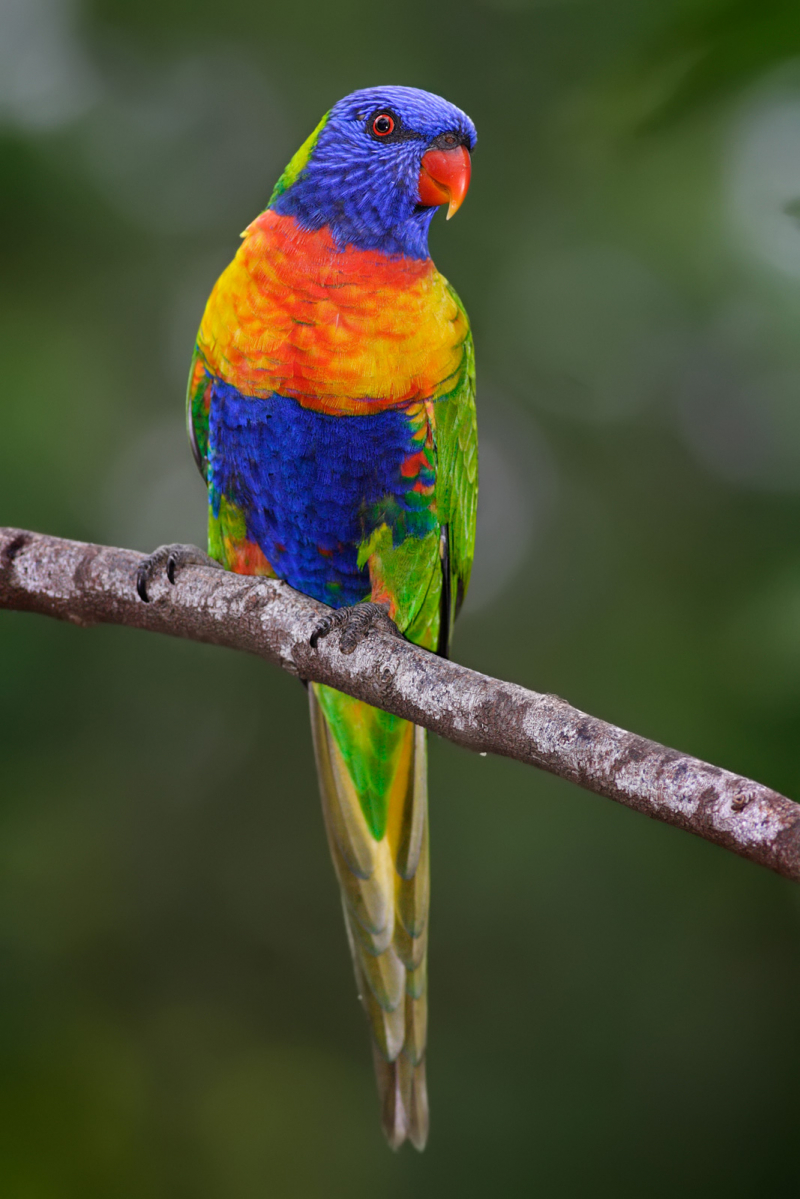
Wikipedia -
The Crimson Rosella (Platycercus elegans) is a parrot native to eastern and south eastern Australia which has been introduced to New Zealand and Norfolk Island. The fruit, seeds, nectar, berries, and nuts of a broad variety of plants, including those in the Myrtaceae, Asteraceae, and Rosaceae families, are foraged by crimson rosellas in trees, shrubs, and on the ground. Despite eating both fruits and seeds, rosellas are ineffective as seed dispersers for plants because they mutilate and obliterate the seeds as they consume them.
It is an Australian parrot of medium size, about 36 cm in length, most of which is the tail. In south-eastern populations, adults and juveniles typically have drastically contrasting coloration, with the juvenile's body plumage being predominately greenish-olive and being particularly noticeable on the nape and breast. As juveniles get older and change from green to red, they are referred to as "ripen". All races feature blue cheeks, black-scalloped blue-margined wings, a tail with a mostly blue and red hue, and blue cheeks. One of the satin bowerbird's favorite ornaments is the blue tail feather of the crimson rosella. The bill is pale grey and the iris dark brown.
eBird 
CRITTERFACTS -
Hyacinth Macaws are the largest flying parrot species in the world, measuring an astonishing 100 cm in length. They live in Northern Brazil's savanna grasslands and semi-open spaces. Over the past few years, their population has decreased. Less than 5000 Hyacinth Macaws are still alive today. The two biggest dangers to hyacinth macaws are habitat loss and hunting.
The Hyacinth Macaw is renowned for its huge size as well as its beautiful azure blue plumage and vivid yellow eye-rings. Hyacinth Macaws are often known as "blue macaws" because of their magnificent coloration. Additionally, they have a stunning long tail and a powerful, curved black bill. Hyacinth Macaws could make wonderful pets with the right training. You should also offer them a lot of space to ensure their comfort. They are exceedingly silly and not as proficient at mimicking speech as some other Macaw family members.
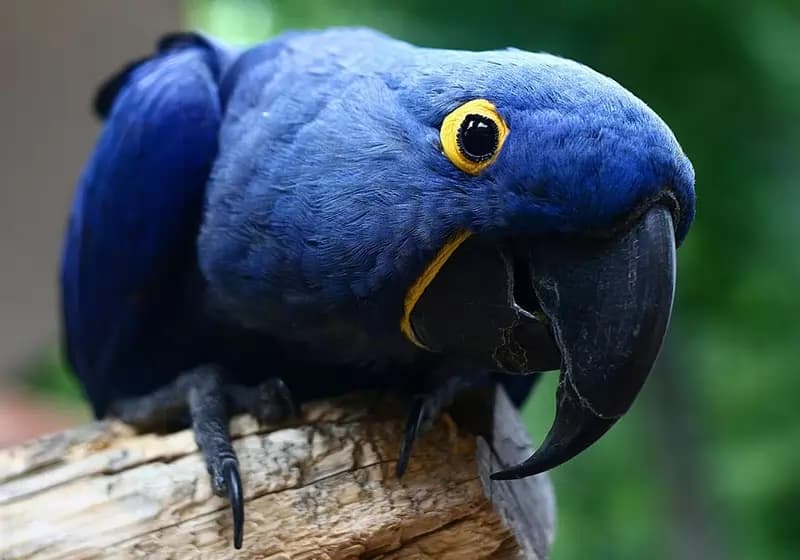
SUNIRA WIKIMEDIA 
Animal of Things -
One of the largest and most beautiful members of the macaw family is the Scarlet Macaw. They live in Central and South America's wet evergreen woods. They are renowned for having vibrant plumage, blue backs and brilliant red fronts, and yellow upper wings with green edges. Another distinguishing characteristic of a scarlet macaw is its powerful, curled beak. The tip is black, while the upper section is white. An adult scarlet macaw measures 80 to 90 cm in length and can weigh up to 1.5 kg. They fly quite well and may go at speeds of up to 35 mph. Scarlet macaws have a longer lifespan as well. These animals have a lifespan of 40-50 years. It is said to be that scarlet macaws in captivity can live up to 75 years.
The magnificent, scarlet macaw is also among the most intelligent birds in the world. They are easily taught language, sounds, and tricks while kept in captivity. A well-trained scarlet macaw is claimed to be able to recognize both colors and shapes. Scarlet macaws are boisterous parrots as well. They have a variety of vocalizations, including screeches and squawks. Their primary food sources include insects, fruits, seeds, and nuts. Scarlet macaws have a powerful, curved beak that can readily crush any nuts.

The Spruce Pets 
iStock -
The Galah (Eolophus roseicapilla), also known as the pink and grey cockatoo or rose-breasted cockatoo, is the only species within the genus Eolophus of the cockatoo family. It is one of the cockatoos that are most widely distributed throughout Australia. Galahs make their nests in tree cavities. The white eggs often come in clutches of two to five. The male and female share the incubation of the eggs, which lasts for around 25 days. About 49 days after hatching, the chicks depart the nest.
The galah has a length of around 35 cm and weighs 270–350 g. Its features include a pink face, pink breast, a light pink movable crest, pale silver to grey back, and a pale grey rump. The naked skin of the eye ring is carunculated, and its beak is bone-colored. Its legs are gray. Although the sexes appear to be similar, adult birds have different eye colors. The males have very dark brown (nearly black) eyes, while the females have mid-brown or red eyes. The colors of adults are more vivid than those of juveniles. Juveniles have brown irises with pale, non-carunculated eye rings, a greyish breast, head, and crest.

eBird 
eBird -
The Blue-and-Yellow Macaw (Ara ararauna), also known as the blue-and-gold macaw, is a large South American parrot. It is a member of a large group of neotropical parrots known as macaws. It lives in tropical South American forests (particularly varzea, but also wide areas of terra firme or unflooded forest), woodland, and savannah. They are popular in aviculture due to their eye-catching color, talkativeness, easy accessibility to consumers, and tight relationship with people.
These birds are among the bigger members of their family, growing to a length of 76-86 cm and a weight of 0.900-1.5 kg. They have beautiful aqua blue feathers on the top of their bodies, with the exception of their head, which is lime green. However, the bottom has a gorgeous deep yellow/light orange color. The feathers under their chin and their beak are also black. With the exception of black talons, its feet are gray in hue. The bird has white skin, and the only feathers on its face are a few sparse black ones that make a striped pattern around its eyes when they are separated from one another. Irises are a light yellow color.

Wikipedia 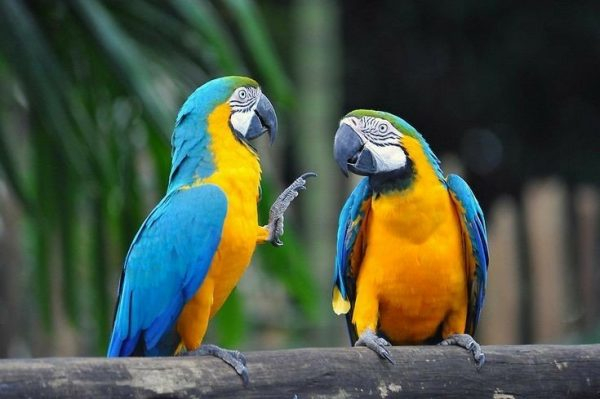
eBird -
The Dusky Lory (Pseudeos fuscata) is a species of parrot in the family Psittaculidae. Alternative common names are the white-rumped lory or the dusky-orange lory. The dusky lory's natural habitat is in New Guinea's Indonesian (West Papua) and Papua New Guinean zones, below an elevation of around 2500 meters. Additionally, it is indigenous to the neighboring Indonesian islands of Yapen and Salawati. Subtropical or tropical mangrove forests, subtropical or tropical moist lowland forests, and subtropical or tropical moist montane forests are its native habitats.
The dusky lory is a short-tailed parrot about 25 cm long. It is mainly brown and has a whitish back and rump. Its back and rump are yellowish, and most of its body is brown. It has two color phases; its abdomen and band across the top of its thorax are either yellow or orange. At the base of its lower jaw, where the beak would normally be, there is a patch of exposed orange skin. The legs are grey, and the irises are crimson. Externally, there is no difference between males and females. The irises of juveniles are yellowish-grey, their backs and rumps are yellowish, and their beaks are yellow at the base and brown/black at the tip.

Wikipedia 
Australian Geographic -
The Turquoise-Fronted Amazon (Amazona aestiva), also called the turquoise-fronted parrot, the blue-fronted amazon and the blue-fronted parrot is a South American species of amazon parrot and one of the most common amazon parrots kept in captivity as a pet or companion parrot. Its common name is derived from the distinctive turquoise marking on its head just above its beak.
The turquoise-fronted amazon is a 38 cm long, primarily green parrot. They have yellow feathers on their face and crest, and blue feathers above their beak on their forehead. Blue and yellow distribution vary widely between people. Its beak is predominantly black, in contrast to most other Amazona parrots. The feathers do not exhibit overt sexual dimorphism to the human eye, but spectrometric analysis, which reproduces a parrot's tetrachromatic vision, reveals distinct differences between the sexes' feathers. Parrot juveniles have darker irises and a duller appearance.

Wikipedia 
Wikipedia -
The Sun Parakeet (Aratinga solstitialis), also known in aviculture as the sun conure, is a medium-sized, vibrantly colored parrot native to northeastern South America. Although they are typically found in tropical environments, sun conures' precise ecological needs are still not well understood. They are frequently described as living in coastal forests and dry savanna woodlands, but recent sightings indicate that they actually prefer lower elevations, near the edges of humid forests in the Guiana Shield foothills, and only cross more open savannah habitats when moving between patches of forest. Sun conures have been spotted in coastal, periodically flooded woods, forested valleys, and shrublands along the bank of the Amazon River. These conures typically live in palm groves and fruit trees.
The underparts and face of the mature male and female are orange-flushed, with the majority of their plumage being golden yellow. Sun parakeets are extremely gregarious creatures and frequently live in flocks. They breed in monogamous pairs and build their nests in tropical palm cavities. Fruits, flowers, berries, petals, seeds, nuts, and insects are the main sources of food for sun parakeets. Conures can live up to 30 years and are frequently bred and maintained in aviculture. Current threats to this species include habitat degradation, trapping for the pet trade, or for its plumage. The IUCN (International Union for Conservation of Nature) currently lists sun parakeets as threatened.

Wikipedia 
Wikipedia -
The Sulphur-Crested Cockatoo (Cacatua galerita) is a relatively large white cockatoo found in wooded habitats in Australia, New Guinea, and some of the islands of Indonesia. They can be locally very numerous, leading to them sometimes being considered pests. They are well recognized in aviculture and are highly intelligent birds, despite the fact that they may be demanding companions.
The Australian subspecies of the sulfur-crested cockatoo are larger than the subspecies from New Guinea and adjacent islands, measuring 44–55 cm in length. While the underwing and tail are tinged yellow, the predominant color of the plumage is white. The colorful crest is expressive. The eye-ring is whitish, the beak is black, and the legs are grey. Males typically have practically black eyes, while females typically have more red or brown eyes, albeit this can only be observed under ideal viewing conditions.

eBird 
Wikipedia























